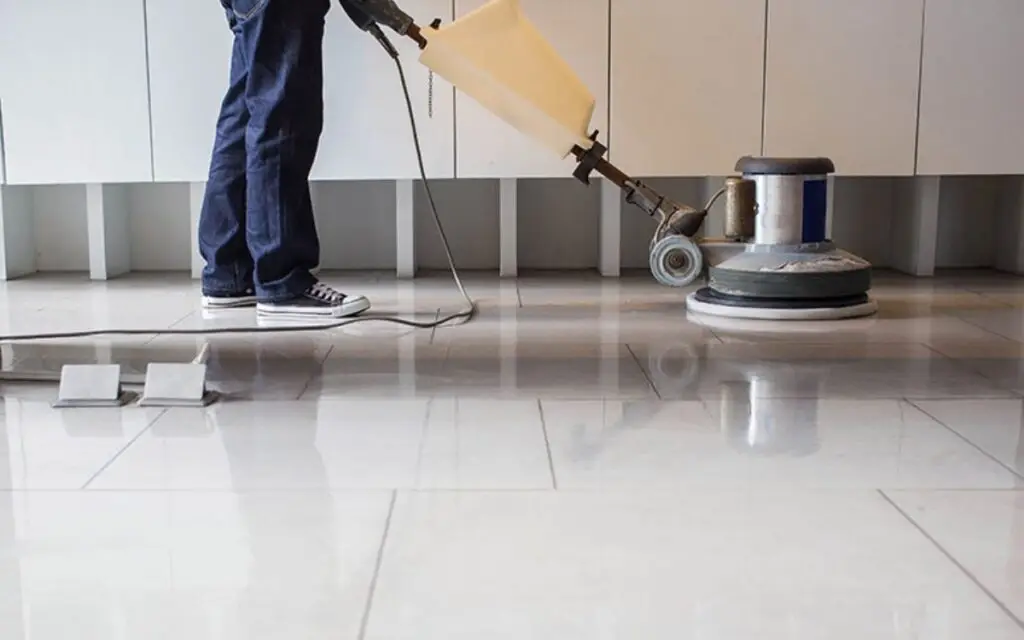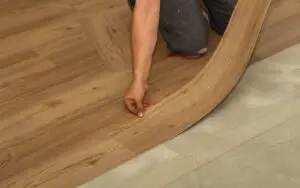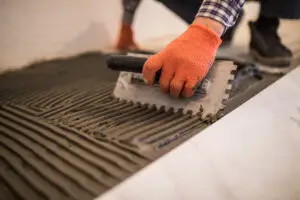Understanding Floor Finishes
What is Floor Wax?
Composition and Purpose
Floor wax is a protective coating made from natural or synthetic waxes, such as carnauba wax, beeswax, or polyethylene wax. Its primary purpose is to provide a temporary shine and protective layer on the floor’s surface. Wax creates a glossy finish, while also helping to protect the flooring material from scratches, scuffs, and dirt.
Traditional and Modern Waxes
Traditional floor waxes typically come in paste or liquid form and require buffing to achieve a shine. Modern waxes may contain polymers for enhanced durability and ease of application. Both types of waxes serve the same basic purpose of providing shine and protection, however modern waxes often have properties that will make them easier to maintain, and longer lasting.
What is Floor Polish?
Composition and Purpose
Floor polish is a liquid product containing polymers, such as acrylic or urethane, that is designed to create a hard, durable, and long-lasting protective layer on the floor. Unlike wax, polish does not require buffing, and it will also provide a more durable finish that is highly resistant to scratches, stains, and moisture.
Types of Floor Polish
There are many different types of floor polish available, including acrylic polishes, urethane polishes, and polymer-based finishes. The best type of floor polish for your specific needs will depend on the type of flooring that you have, and the level of durability and shine that you are hoping to achieve. Professional flooring installers are well versed in all of the different types of floor polishes, and can help you make the best choices for your home or business.
Key Differences Between Floor Wax and Floor Polish
Application
Waxing Process
The waxing process involves applying a thin, even layer of wax to the floor, using an applicator pad, or a mop. The wax will then need to dry for a certain amount of time, which can vary depending on the product being used. Once the wax is dry, it will need to be buffed with a polishing machine, to create a shine.
Polishing Process
The polishing process typically involves cleaning the floor, and then applying a thin, even layer of polish, using a mop or applicator pad. The polish will then need to dry completely, and will often not require any buffing, or other additional steps. Professional installers will also have specific techniques that can help you achieve a beautiful and long-lasting result.
Durability
Waxed Floors
Waxed floors will offer a decent level of protection from scratches and scuffs, but the wax layer is relatively soft, and can wear down quickly, especially in high-traffic areas. This means that waxed floors will require more frequent maintenance, such as buffing and re-waxing, to maintain their shine and protection.
Polished Floors
Polished floors offer much greater durability, and resistance to wear and tear, as the polymer-based finish is much harder, and more scratch-resistant, than wax. Polished floors also hold up better to water, and are less likely to be damaged by spills, and frequent cleaning. These qualities make polished floors a much better option for high-traffic areas.
Appearance
Waxed Floors
Waxed floors often provide a warm, and traditional shine, that many homeowners find appealing. The wax can also enhance the natural color, and grain, of the wood, and it can also create a smooth, and even surface.
Polished Floors
Polished floors typically offer a more modern, and glossy shine, that can add a touch of elegance to any space. Polished floors can also be formulated to create a matte finish, which provides a more subtle, and understated look. The appearance of polished floors is also determined by the type of polish that is used, and it is important to always make sure you choose the right type of finish for your specific needs.
Maintenance
Waxed Floors
Waxed floors require frequent buffing, to maintain their shine, and will also need to be re-waxed every few months, or years, depending on the amount of traffic that they receive. Waxed floors are also more sensitive to water, and chemicals, and should only be cleaned with pH-neutral cleaners, to avoid damage.
Polished Floors
Polished floors are generally easier to maintain than waxed floors, and they only require routine cleaning, with a damp mop, and occasional re-polishing, as needed. They are also more resistant to water, and chemicals, and can be cleaned with a wider variety of cleaning products. Professional installers can always advise you on the best steps to take, to protect and maintain your polished floors.
Choosing the Right Finish for Your Floors
Factors to Consider
Type of Flooring
The type of flooring that you have, is the most important factor to consider, when choosing between wax and polish. Some types of flooring, such as hardwood, can be finished with either wax or polish, while other types of flooring, such as laminate or vinyl, are only suitable for polishing. It is essential to consult the manufacturer’s recommendations, or a professional installer, to determine which finish is best for your specific flooring type.
Desired Appearance
You should also consider the desired appearance, when choosing between wax, and polish. If you prefer a more traditional look, with a warm, and subtle shine, then wax may be the best option for you. If you prefer a more modern look, with a glossy, and reflective shine, then polish may be the better choice.
Maintenance Requirements
You should also consider the amount of time, and effort, that you are willing to invest in maintaining your floors. If you want a low-maintenance finish, that is easy to clean, then polish may be the best option for you. If you are willing to invest more time, in frequent buffing, and re-waxing, then wax may be a better choice.
Professional Advice
Expertise
Professional flooring installers have all of the expertise and knowledge, to assess your specific needs, and recommend the best finish for your floors. They will also be able to provide expert guidance on the proper cleaning, and maintenance, techniques, to ensure that your floors look their best, for many years to come.
Long-Term Benefits
Hiring a professional flooring installer, will ensure that your floors are properly finished, and protected, which will extend their lifespan, and will also enhance their appearance. Professional installers also offer warranties on their work, which will provide you with peace of mind, knowing that your investment is protected.
DIY vs Professional Floor Finishing
Challenges of DIY Waxing and Polishing
Potential for Mistakes
DIY waxing, and polishing projects, are prone to a number of potential mistakes, such as uneven application, swirl marks, and damage to the flooring surface. Without the proper knowledge, and experience, it can be very difficult to achieve professional-looking results.
Equipment and Skills
Waxing, and polishing, also require specialized equipment, such as polishing machines, and buffing pads, and if you do not already have these tools, you will have to rent, or purchase them, which can be very costly. It is also essential to have the proper skills and techniques, to use the equipment safely and effectively.
Benefits of Professional Services
Expertise and Precision
Professional floor finishing services bring expertise and precision to every project. They have the tools, techniques, and knowledge, to ensure a flawless finish that is both beautiful, and durable.
Quality Products
Professionals use only high-quality waxes and polishes, and will always make sure to select the proper products for the specific type of flooring, and the desired results. Using the correct materials, is essential for ensuring a beautiful and long-lasting floor.
Long-Term Value
Professional floor finishing often provides better long-term value by preventing costly mistakes, and ensuring a durable, and long-lasting, finish. It is also a great way to protect your investment, and ensure that your floors add value, and beauty, to your home or business.
Case Studies: Waxing vs Polishing Outcomes
Example of a Properly Waxed Floor
A homeowner chose to wax their antique hardwood floors, to preserve their traditional look, and enhance their natural beauty. They hired a professional installer, to perform the waxing, and they diligently followed the recommended maintenance procedures. As a result, the floors retained their warm, and inviting shine, and continued to look great for many years.
Example of a Professionally Polished Floor
Another homeowner chose to have their concrete floors professionally polished, to create a modern, and industrial look. The professional installer used a high-quality polishing compound, and a specialized polishing machine, and the floors had a beautiful, and durable shine, that enhanced the value of the entire home.
FAQs & Answers
The fundamental difference between floor wax and floor polish is that floor wax is a coating made from natural or synthetic waxes, designed to protect the floor and provide a temporary shine, while floor polish is a liquid product containing polymers, that creates a hard, durable, and long-lasting protective layer. Professional installers can guide you in which product is the best for your needs and your flooring.
Waxing floors involves applying a thin layer of wax with an applicator and then buffing the floor to create a shine. Polishing floors typically involves using a floor polishing machine with specialized pads and polishing compounds, to create a high-gloss finish. While both can be DIYed, professional installers have all the tools, and the expertise, to ensure a great looking, and long-lasting result.
Floor polish generally offers greater durability and resistance to wear and tear than floor wax, as it forms a hard, protective layer that is more resistant to scratches, scuffs, and stains. However, the type of flooring also needs to be considered, as certain floors should always be waxed, while others should always be polished. A professional installer is always familiar with which options are best for which type of flooring.
Waxed floors typically require more frequent maintenance, including regular buffing and occasional re-waxing, to maintain their shine and protection. Polished floors are generally easier to maintain, requiring only routine cleaning with a damp mop and occasional re-polishing as needed. While both are easy to maintain, it is also important to make sure that all types of floors are properly maintained by professionals, to protect your investment, and ensure long-lasting beauty.
A homeowner might choose to wax their floors for a traditional look, and to preserve a specific aesthetic, while a homeowner might choose to polish their floors for greater durability, easier maintenance, and a more modern look. The choice will often depend on personal preferences, and the type of flooring in question. If you are unsure of which process is best for you, you should always seek the advice of a professional, who is familiar with all types of flooring techniques.





